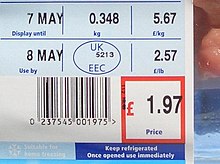
Back تاريخ الصلاحية Arabic Data de consum Catalan Datum použitelnosti Czech Verbrauchsdatum German Fecha de caducidad Spanish Iraungipen-data Basque Viimeinen käyttöpäivä Finnish Date limite de consommation French Data de caducidade Galician Tanggal kedaluwarsa ID

An expiration date or expiry date is a previously determined date after which something should no longer be used, either by operation of law or by exceeding the anticipated shelf life for perishable goods. Expiration dates are applied to selected food products and to some other manufactured products like infant car seats where the age of the product may impact its safe use.[1]
The legal definition and usage of terms will vary between countries and products. Different terms may be used for products that tend to spoil and those that tend to be shelf-stable. The term Use by is often applied to products such as milk and meat that are more likely to spoil and can become dangerous to those eating them. Such products should not be consumed past the date shown. The term Best before is often applied to products that may deteriorate slightly in quality, but are unlikely to become dangerous as a result, such as dried foods. Such products can be eaten after their Best before date at the discretion of the consumer. Storage and handling conditions will affect whether and when an item will spoil, so there is inherent variability in dating.[2][3]
A time temperature indicator is a sensing label or device that indicates whether a product has been exposed to dangerously high or low temperatures. These indicators are often used for determining whether a product is spoiled due to external factors even if it is before the expiration date.
Arbitrary expiration dates are also commonly applied by companies to product coupons, promotional offers and credit cards. In these contexts, the expiration date is chosen for business reasons or to provide some security function rather than any product safety concern. Expiration date is often abbreviated EXP or ED.
- ^ "Have you checked the expiration date on your child's car seat? - The Globe and Mail". The Globe and Mail. 20 April 2011.
- ^ Cite error: The named reference
Steelewas invoked but never defined (see the help page). - ^ Taormina, Peter J. (2021). Food Safety and Quality-Based Shelf Life of Perishable Foods. Springer Nature. ISBN 978-3-030-54375-4.